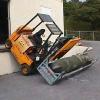I'm having difficulties ripping 4/4 hard maple on my TS (Bosch 4001 w/ Freud glue line rip blade *using the Grr-ripper*). I can't seem to get a straight line when ripping. I don't have much of a problem cutting softer woods straight, but on hard maple it always seems to veer. Could it be that my TS is underpowered for cutting hard maple?
I was considering trying to make some sort of ripping sled in hopes that maybe it would help control the cut while also keeping safety in mind. Are there any ripping sleds that would work if i'm only ripping 20" long boards?
Also, would a decent band saw (14") ($600-800 range) be better for ripping hard maple if i'm ripping often? I'm starting a small cutting board business as a hobby so I will be making repeated 1.25" wide strips on 4/4 hard maple.
Here is what i'm making, but i'd like to be a little more efficient with the whole process.





 Reply With Quote
Reply With Quote












